Abstract
1. In rats anaesthetized with Saffan we have studied the effects of the adenosine receptor antagonists, theophylline and 8-phenyltheophylline, upon the respiratory and cardiovascular responses evoked by 5 min periods of systemic hypoxia. 2. In the group of animals that were to receive theophylline (15 mg kg-1 i.v.), arterial O2 pressure (Pa,O2) fell from 83 +/- 2 mmHg during air breathing to 38 +/- 3 or 34 +/- 3 mmHg during the 5th minute of two different control periods of hypoxia, while in the group that were to receive 8-phenyltheophylline (10 mg kg-1 i.v.), Pa,O2 fell from 83 +/- 1 to 53 +/- 2 mmHg. Neither drug significantly altered the levels of Pa,O2 reached during hypoxia. 3. During the control periods of hypoxia respiration increased, but the increase evoked at the 5th minute was significantly less than that evoked at the 2nd minute of hypoxia. This secondary waning of the hyperventilation was abolished by both drugs. 4. Similarly, both drugs attenuated the tendency for the hypoxia-induced tachycardia to wane between the 2nd and 5th minute. 5. Further, both drugs substantially reduced both the hypoxia-induced fall in arterial pressure and the increases in vascular conductance in hindlimb muscle, carotid vasculature and kidney. 6. Thus, we propose that in the rat the release of adenosine by hypoxic tissues makes a major contribution to the secondary decrease in respiration and heart rate that occurs during systemic hypoxia and to the accompanying vasodilatation in muscle and fall in arterial pressure. The effects of the adenosine antagonists on the carotid and renal vasculature are more equivocal and may be partly explained as a smaller autoregulatory dilatation to a smaller fall in systemic arterial pressure. 7. These results and proposals are discussed in relation to the conditions that are known to cause release of adenosine and in relation to its known effects upon the respiratory and cardiovascular systems.
Full text
PDF



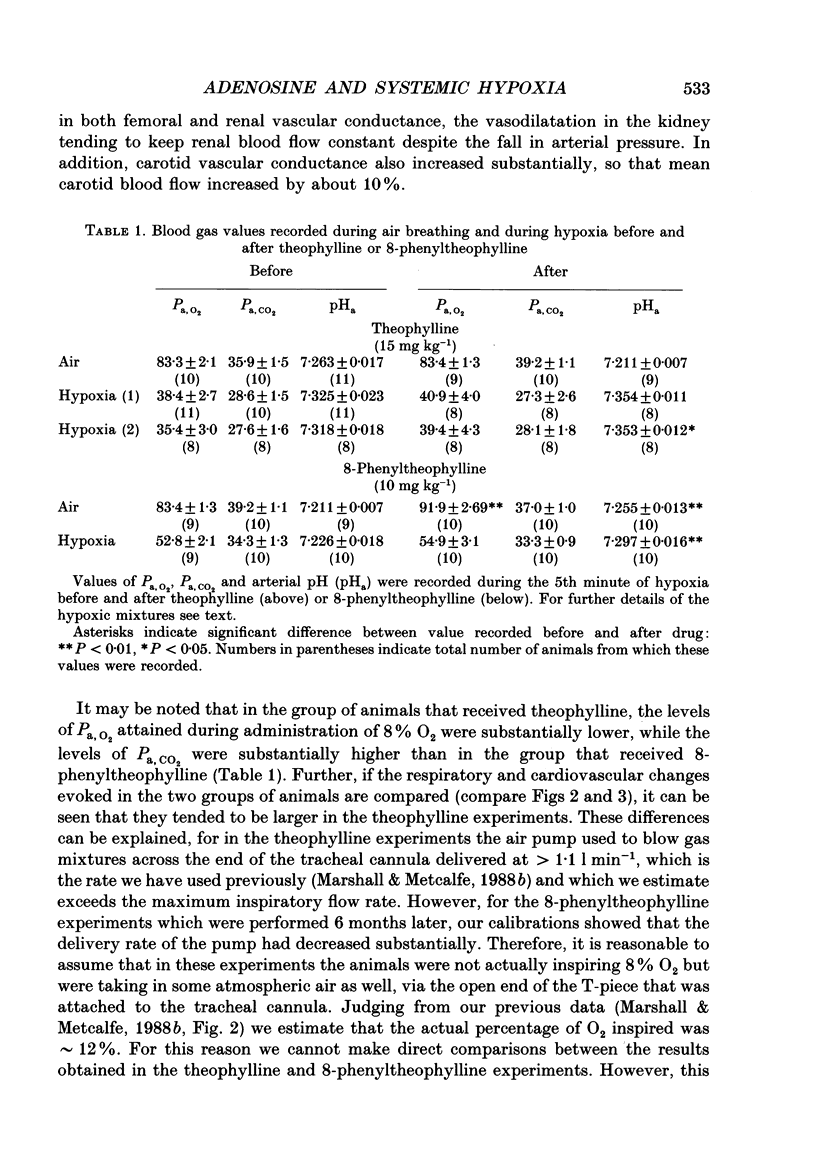
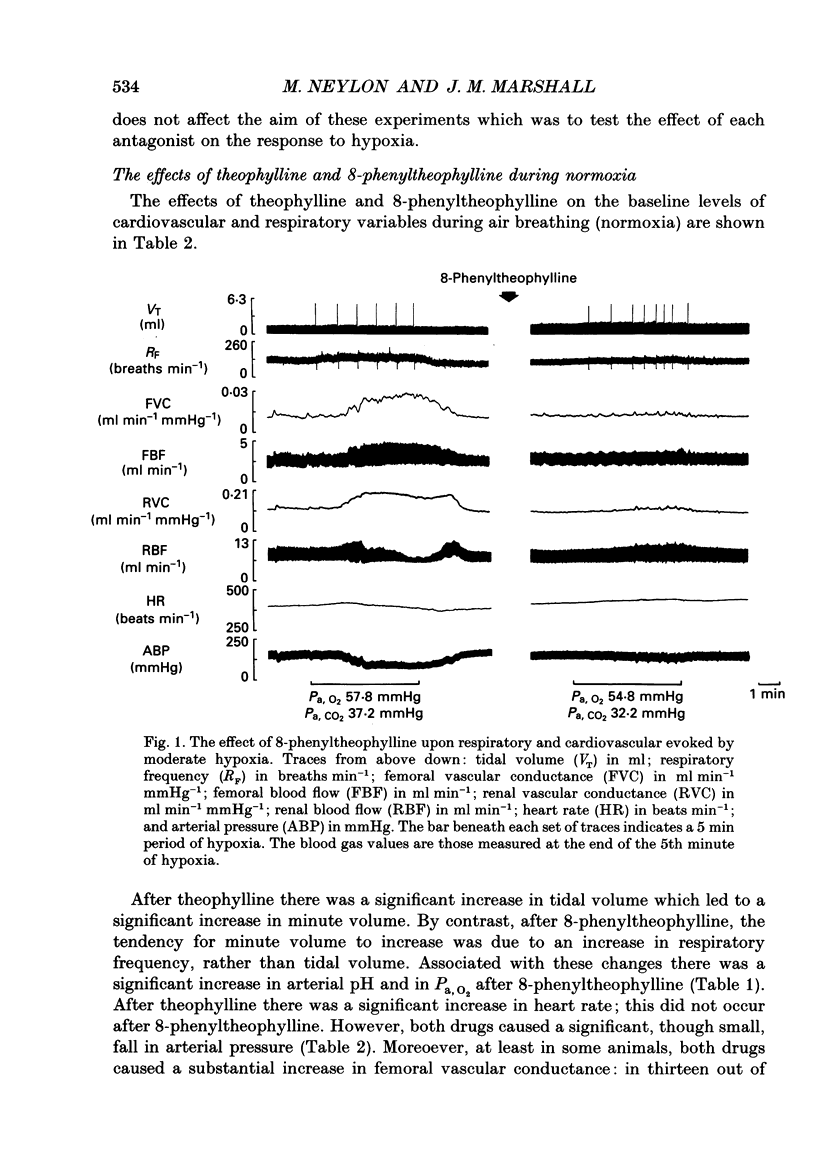
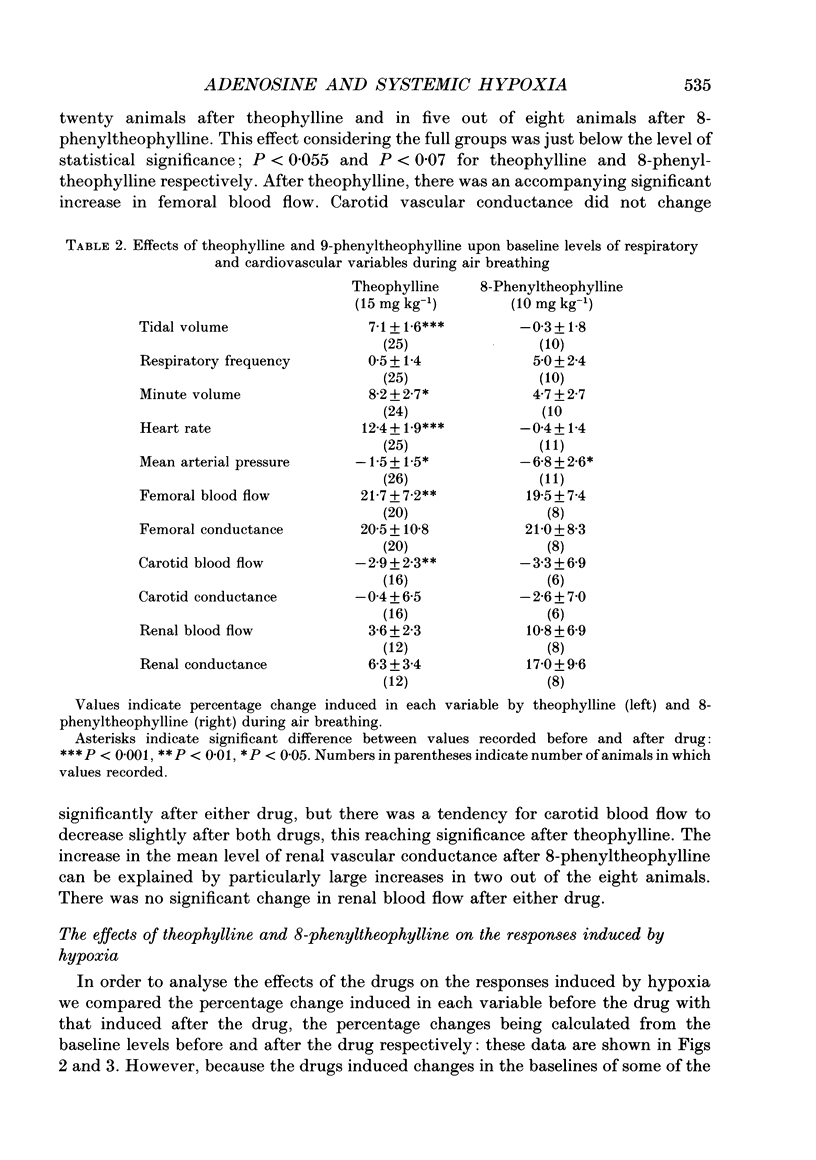
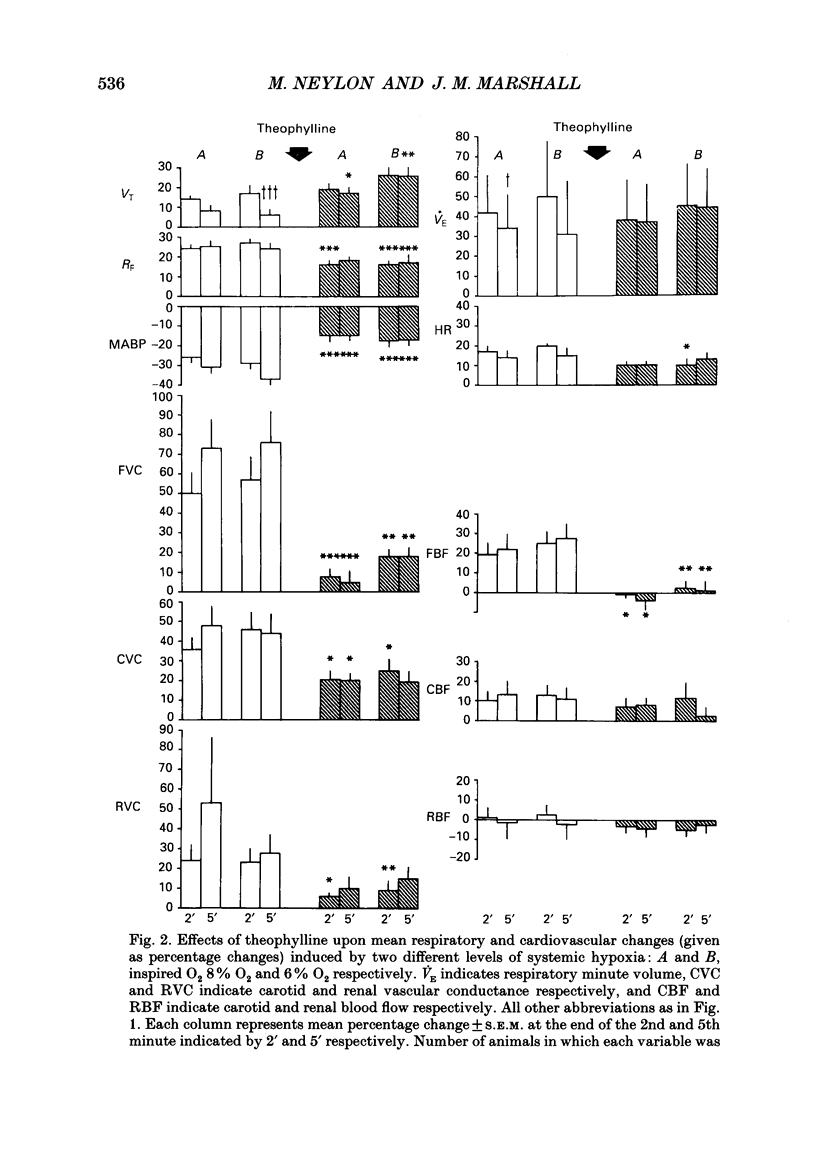


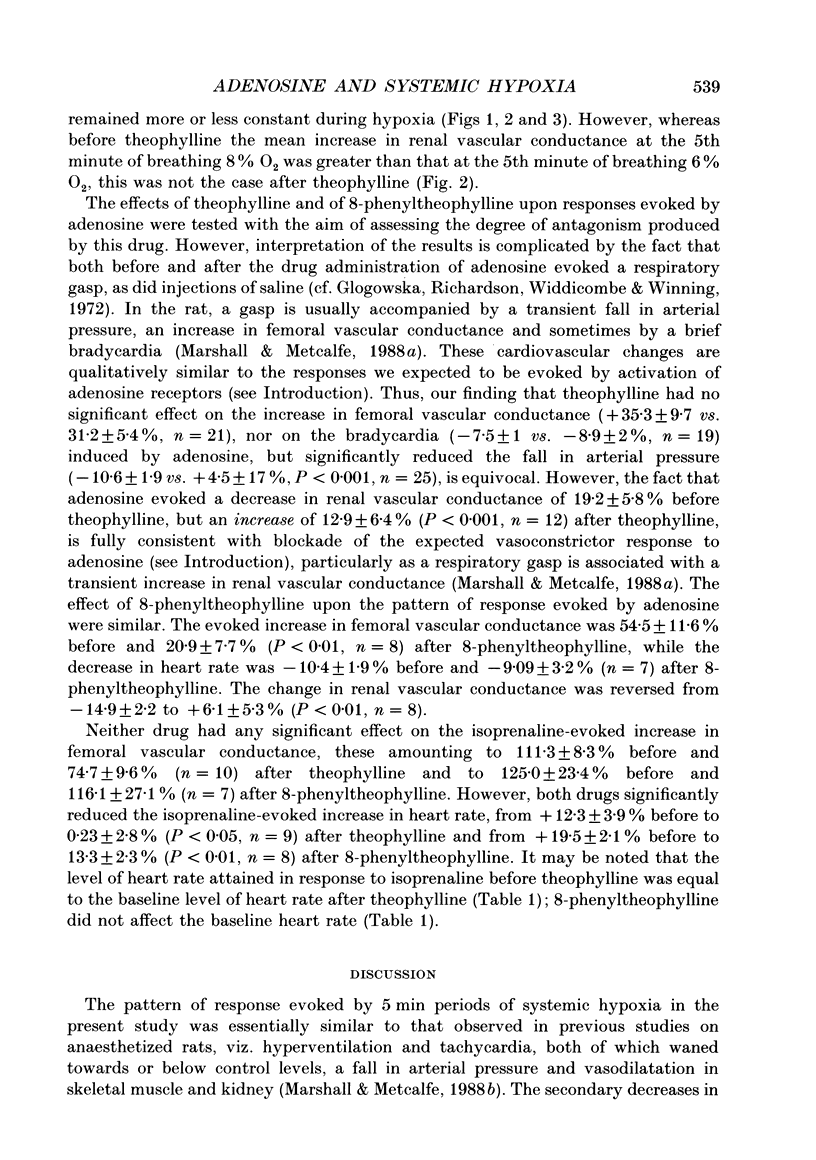
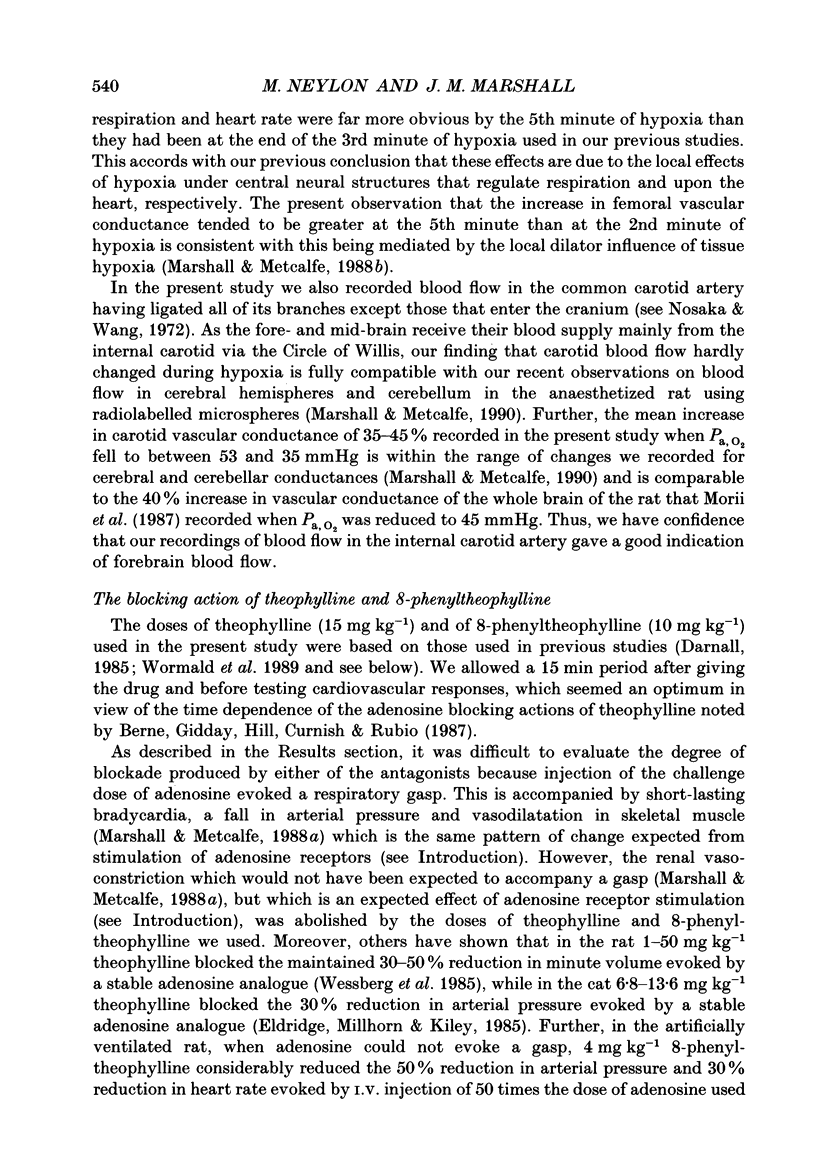

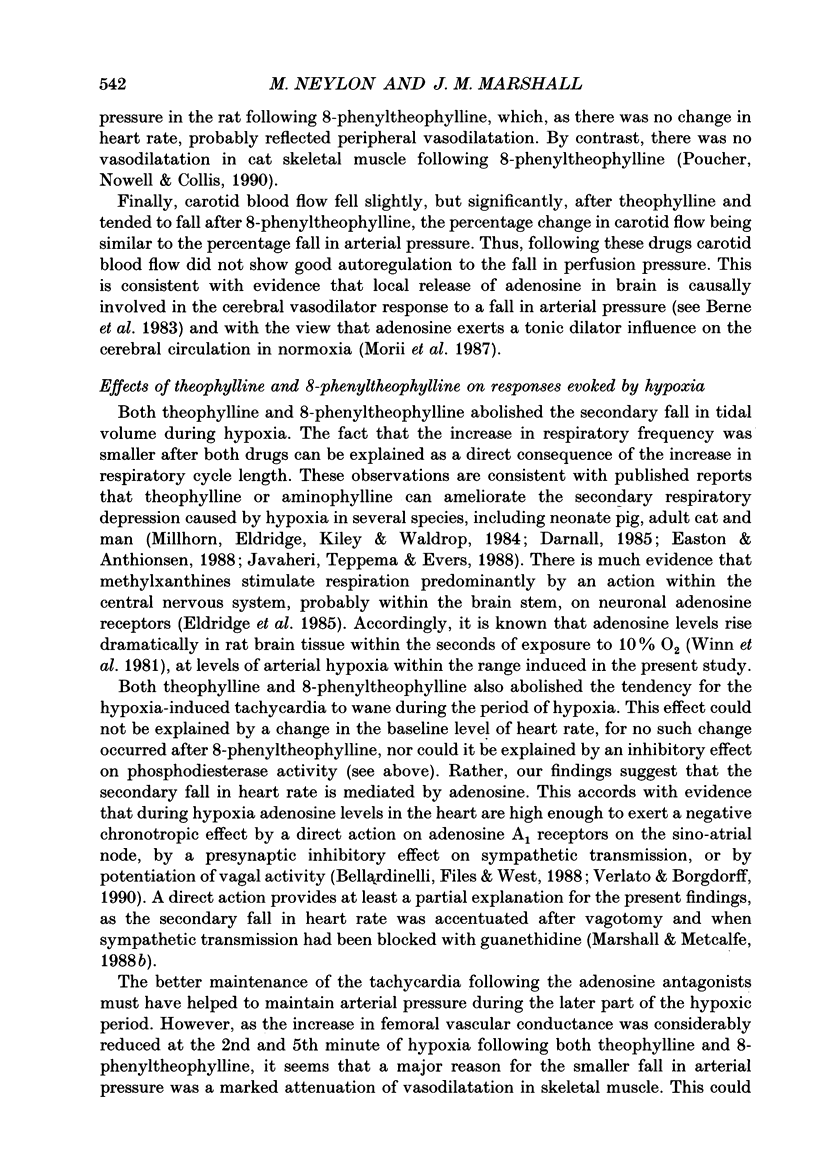


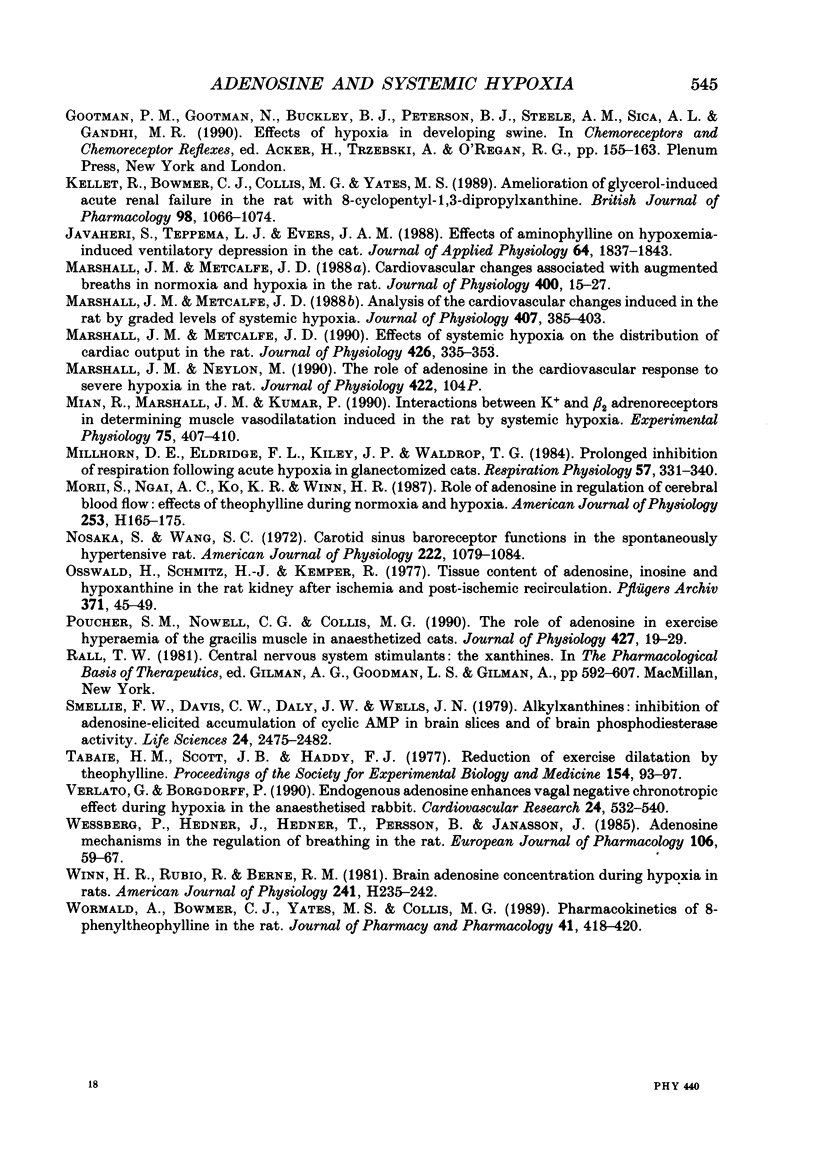
Selected References
These references are in PubMed. This may not be the complete list of references from this article.
- Aranda J. V., Turmen T. Methylxanthines in apnea of prematurity. Clin Perinatol. 1979 Mar;6(1):87–108. [PubMed] [Google Scholar]
- Belardinelli L., Giles W. R., West A. Ionic mechanisms of adenosine actions in pacemaker cells from rabbit heart. J Physiol. 1988 Nov;405:615–633. doi: 10.1113/jphysiol.1988.sp017352. [DOI] [PMC free article] [PubMed] [Google Scholar]
- Bockman E. L., Berne R. M., Rubio R. Adenosine and active hyperemia in dog skeletal muscle. Am J Physiol. 1976 Jun;230(6):1531–1537. doi: 10.1152/ajplegacy.1976.230.6.1531. [DOI] [PubMed] [Google Scholar]
- Bockman E. L., Berne R. M., Rubio R. Release of adenosine and lack of release of ATP from contracting skeletal muscle. Pflugers Arch. 1975 Mar 26;355(3):229–241. doi: 10.1007/BF00583686. [DOI] [PubMed] [Google Scholar]
- Bockman E. L., McKenzie J. E. Tissue adenosine content in active soleus and gracilis muscles of cats. Am J Physiol. 1983 Apr;244(4):H552–H559. doi: 10.1152/ajpheart.1983.244.4.H552. [DOI] [PubMed] [Google Scholar]
- Collis M. G. The vasodilator role of adenosine. Pharmacol Ther. 1989;41(1-2):143–162. doi: 10.1016/0163-7258(89)90104-6. [DOI] [PubMed] [Google Scholar]
- Darnall R. A., Jr Aminophylline reduces hypoxic ventilatory depression: possible role of adenosine. Pediatr Res. 1985 Jul;19(7):706–710. doi: 10.1203/00006450-198507000-00014. [DOI] [PubMed] [Google Scholar]
- Easton P. A., Anthonisen N. R. Ventilatory response to sustained hypoxia after pretreatment with aminophylline. J Appl Physiol (1985) 1988 Apr;64(4):1445–1450. doi: 10.1152/jappl.1988.64.4.1445. [DOI] [PubMed] [Google Scholar]
- Eldridge F. L., Millhorn D. E., Kiley J. P. Antagonism by theophylline of respiratory inhibition induced by adenosine. J Appl Physiol (1985) 1985 Nov;59(5):1428–1433. doi: 10.1152/jappl.1985.59.5.1428. [DOI] [PubMed] [Google Scholar]
- Eldridge F. L., Millhorn D. E., Waldrop T. G., Kiley J. P. Mechanism of respiratory effects of methylxanthines. Respir Physiol. 1983 Aug;53(2):239–261. doi: 10.1016/0034-5687(83)90070-1. [DOI] [PubMed] [Google Scholar]
- Glogowska M., Richardson P. S., Widdicombe J. G., Winning A. J. The role of the vagus nerves, peripheral chemoreceptors and other afferent pathways in the genesis of augmented breaths in cats and rabbits. Respir Physiol. 1972 Oct;16(2):179–196. doi: 10.1016/0034-5687(72)90050-3. [DOI] [PubMed] [Google Scholar]
- Javaheri S., Teppema L. J., Evers J. A. Effects of aminophylline on hypoxemia-induced ventilatory depression in the cat. J Appl Physiol (1985) 1988 May;64(5):1837–1843. doi: 10.1152/jappl.1988.64.5.1837. [DOI] [PubMed] [Google Scholar]
- Kellett R., Bowmer C. J., Collis M. G., Yates M. S. Amelioration of glycerol-induced acute renal failure in the rat with 8-cyclopentyl-1,3-dipropylxanthine. Br J Pharmacol. 1989 Nov;98(3):1066–1074. doi: 10.1111/j.1476-5381.1989.tb14639.x. [DOI] [PMC free article] [PubMed] [Google Scholar]
- Marshall J. M., Metcalfe J. D. Analysis of the cardiovascular changes induced in the rat by graded levels of systemic hypoxia. J Physiol. 1988 Dec;407:385–403. doi: 10.1113/jphysiol.1988.sp017422. [DOI] [PMC free article] [PubMed] [Google Scholar]
- Marshall J. M., Metcalfe J. D. Cardiovascular changes associated with augmented breaths in normoxia and hypoxia in the rat. J Physiol. 1988 Jun;400:15–27. doi: 10.1113/jphysiol.1988.sp017107. [DOI] [PMC free article] [PubMed] [Google Scholar]
- Marshall J. M., Metcalfe J. D. Effects of systemic hypoxia on the distribution of cardiac output in the rat. J Physiol. 1990 Jul;426:335–353. doi: 10.1113/jphysiol.1990.sp018141. [DOI] [PMC free article] [PubMed] [Google Scholar]
- Mian R., Marshall J. M., Kumar P. Interactions between K+ and beta 2-adrenoreceptors in determining muscle vasodilatation induced in the rat by systemic hypoxia. Exp Physiol. 1990 May;75(3):407–410. doi: 10.1113/expphysiol.1990.sp003416. [DOI] [PubMed] [Google Scholar]
- Millhorn D. E., Eldridge F. L., Kiley J. P., Waldrop T. G. Prolonged inhibition of respiration following acute hypoxia in glomectomized cats. Respir Physiol. 1984 Sep;57(3):331–340. doi: 10.1016/0034-5687(84)90081-1. [DOI] [PubMed] [Google Scholar]
- Morii S., Ngai A. C., Ko K. R., Winn H. R. Role of adenosine in regulation of cerebral blood flow: effects of theophylline during normoxia and hypoxia. Am J Physiol. 1987 Jul;253(1 Pt 2):H165–H175. doi: 10.1152/ajpheart.1987.253.1.H165. [DOI] [PubMed] [Google Scholar]
- Nosaka S., Wang S. C. Carotid sinus baroceptor functions in the spontaneously hypertensive rat. Am J Physiol. 1972 May;222(5):1079–1084. doi: 10.1152/ajplegacy.1972.222.5.1079. [DOI] [PubMed] [Google Scholar]
- Osswald H., Schmitz H. J., Kemper R. Tissue content of adenosine, inosine and hypoxanthine in the rat kidney after ischemia and postischemic recirculation. Pflugers Arch. 1977 Oct 19;371(1-2):45–49. doi: 10.1007/BF00580771. [DOI] [PubMed] [Google Scholar]
- Poucher S. M., Nowell C. G., Collis M. G. The role of adenosine in exercise hyperaemia of the gracilis muscle in anaesthetized cats. J Physiol. 1990 Aug;427:19–29. doi: 10.1113/jphysiol.1990.sp018158. [DOI] [PMC free article] [PubMed] [Google Scholar]
- Smellie F. W., Davis C. W., Daly J. W., Wells J. N. Alkylxanthines: inhibition of adenosine-elicited accumulation of cyclic AMP in brain slices and of brain phosphodiesterase activity. Life Sci. 1979 Jun 25;24(26):2475–2482. doi: 10.1016/0024-3205(79)90458-2. [DOI] [PubMed] [Google Scholar]
- Tabaie H. M., Scott J. B., Haddy F. J. Reduction of exercise dilation by theophylline. Proc Soc Exp Biol Med. 1977 Jan;154(1):93–97. doi: 10.3181/00379727-154-39611. [DOI] [PubMed] [Google Scholar]
- Verlato G., Borgdorff P. Endogenous adenosine enhances vagal negative chronotropic effect during hypoxia in the anaesthetised rabbit. Cardiovasc Res. 1990 Jul;24(7):532–539. doi: 10.1093/cvr/24.7.532. [DOI] [PubMed] [Google Scholar]
- Wessberg P., Hedner J., Hedner T., Persson B., Jonason J. Adenosine mechanisms in the regulation of breathing in the rat. Eur J Pharmacol. 1984 Oct 30;106(1):59–67. doi: 10.1016/0014-2999(84)90678-2. [DOI] [PubMed] [Google Scholar]
- Winn H. R., Rubio R., Berne R. M. Brain adenosine concentration during hypoxia in rats. Am J Physiol. 1981 Aug;241(2):H235–H242. doi: 10.1152/ajpheart.1981.241.2.H235. [DOI] [PubMed] [Google Scholar]
- Wormald A., Bowmer C. J., Yates M. S., Collis M. G. Pharmacokinetics of 8-phenyltheophylline in the rat. J Pharm Pharmacol. 1989 Jun;41(6):418–420. doi: 10.1111/j.2042-7158.1989.tb06491.x. [DOI] [PubMed] [Google Scholar]


